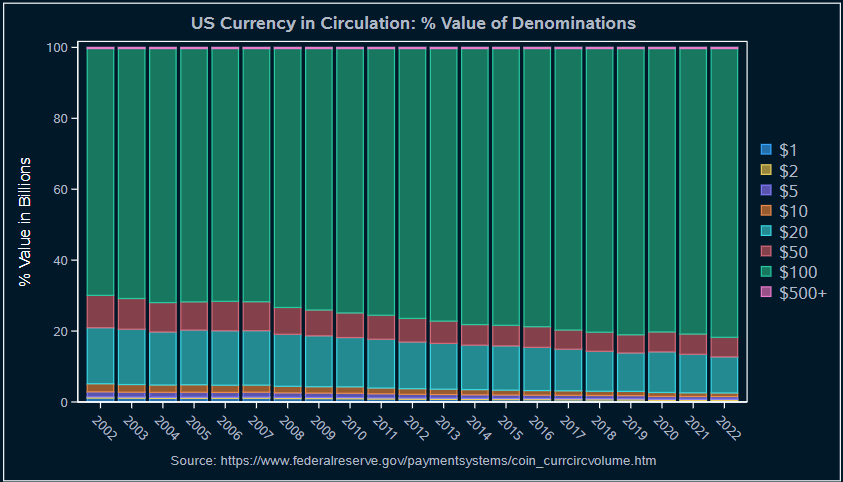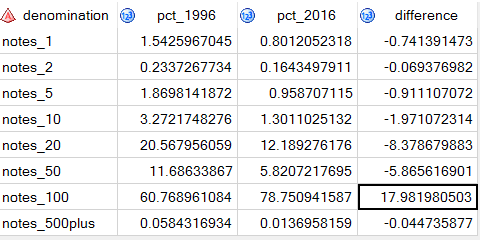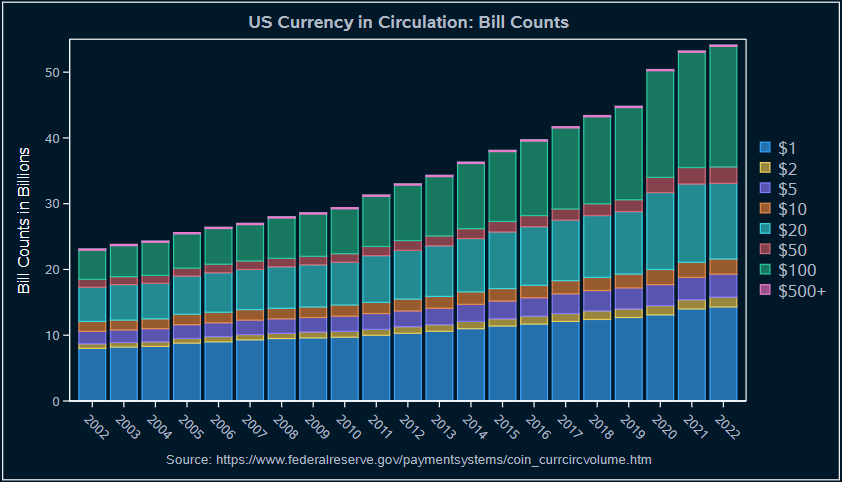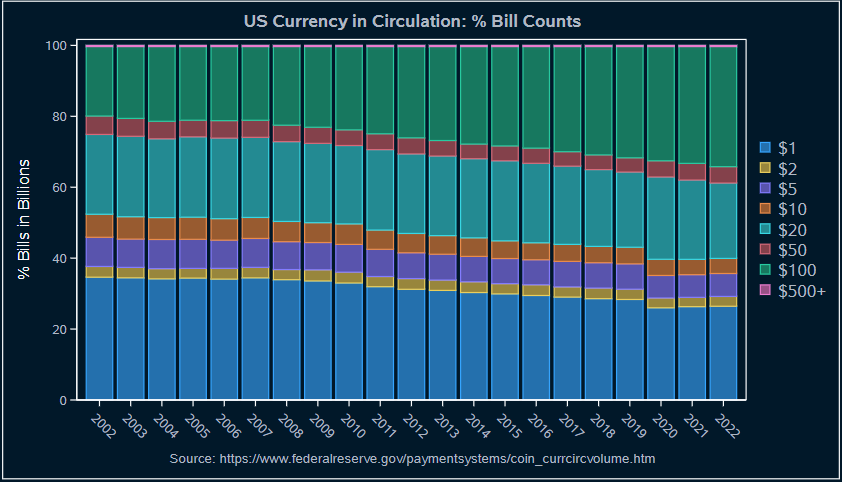This phenomenon has been in the news recently, so I've updated this article that I originally published in 2017. The paper currency in circulation in the US is mostly $100 bills. And not just by a little bit -- these account for 34% of the notes by denomination and nearly 82% of the value (data as of 2022).
I originally wrote this article when I was inspired by a news story on NPR's Morning Edition about the merits and risks of the $100 bill. There are a lot of them in circulation, but no one knows exactly where they are. According to the report, they are seldom used for legitimate business transactions. When a transaction reaches into the hundreds of dollars, the business parties tend to resort to a digital transaction (or maybe a good-old-fashioned personal check). Large cash transactions are often used to avoid taxation or, more nefariously, to hide criminal activity.
It was easy to find the data on the US Federal Reserve: Currency in Circulation web site. I could have copied and pasted the table for use in SAS, but the Fed already makes an ASCII version of the table available for nerds like me. With a bit of SAS code I was able to download the data (using PROC HTTP), transpose it for analysis, calculate the currency values for the counts of the various notes, and create a graph that verifies what I heard on the news. Indeed, much of our nation's cash wealth is floating around on a bunch of Benjamins.

The percentage of wealth represented in the $100 bill has grown over the past 20 years, perhaps at the expense of the far-more-ATM-friendly $20 bill. In 1996, the ratio of hundreds-to-twenties (in cash value) was 61/20. In 2016, it was 79/12. The following table shows the two years side-by-side. $100 bills increased by nearly 18 percentage points, while all other notes decreased. $20 notes were the biggest loser at -8.3 points, and $50 notes were next at -5.8 percentage points.

If we look at the percent breakdown by bill counts (instead of value), you can see the shifts a bit differently.
I created those two plots by calculating the percentages with PROC FREQ, and then using PROC SGPLOT to graph Year, using the percentages as the response value and stacking the data by Denomination. I used GROUPORDER=Data to keep the data colors and legend consistent across the different graphs. The raw values are interesting to examine as well, as it more clearly shows the trends for the past 20 years. Here are the two representations (cash value and bill counts) with their actual values and not just the percentages.

An interesting aside: the $2 bill remains a novelty. I had the opportunity to spend a few of these recently, and the person receiving them had to be convinced that they were real money. It made me want to secure more $2 bills (a.k.a. "some Jeffersons") for future transactions -- that's the sort of trouble-making consumer that I like to be.
In case you're interested, here's the SAS program that I used -- try it yourself! This should work fine in any recent SAS version, including in SAS OnDemand for Academics.



38 Comments
I had the pleasure of being taken around the Capitol in Washington by Andrew Karp a few years ago, who had been an intern there. In the Rotunda he amazed the intern escorting us by producing a $2 bill in front of John Trumbull's Declaration of Independence. I suspect that intern now carries a $2 bill with him at all times too!
Ah, an excellent memory of Andrew. I will spend my next $2 bill in his memory, perhaps to buy a beer to toast to him. Well, I'll probably need at least three of those bills to afford a decent beverage.
Another source of great fun is paying with dollar coins, especially the presidential dollars. Half the clerks don't know what they are and the other half quickly snatch them up by replacing them with their own paper money in the tiller. To bad the only way to order them from my bank is in bricks of 1,000.
Yes! I read that the US Mint is required BY LAW to keep creating these dollar coins, even though we rarely see them in circulation. I have a fantasy that I'll turn into an eccentric old man who hands out dollar coins as a tip for those in the service industry, and perhaps to young people for weird unpredictable reasons. Guess I'd better save up for my brick.
I always got dollar coins as change when using a self-service machine at the post office. I haven't tried it in a while.
Ecuador uses US currency and there are very few $1 bills as they love the coins there.
An easy way to get dollar coins is to go to a post office and buy stamps at the machines in the lobby. The vending machines give dollar coins as change.
USPS doing its part!
I tipped at a Mexican restaurant with three $1 coins one time. The workers were from Mexico, and I thought they would think it was neat getting dollar coins instead of paper. But they were *not* happy about it at all - they had never seen US dollar coins, and didn't know what they were (they assumed maybe it was fake, or quarters, or something).
I would say avoiding taxation was also a criminal activity.
Yes, I agree! But I wouldn't put it in the same category as "drug lord". Any wonder why every crime movie has a scene that features a briefcase of $100 bills? That's where the 80% are!
How about Taxation itself is a crime. I get robbed every paycheck! Hah! Seriously though, this is extremely fascinating and I like your line of thinking.
My mother-in-law uses $100 bills for nefarious purposes. Every time you ask her to pay for something she asks, "Can you break a hundred dollar bill?"
My aunt, on the other hand, is constantly trying to pay me with $2 bills and $1 coins and I say, "Please give me money someone is going to recognize!"
What do you think the odds are our Fed or whoever calls those shots will ban the $100 cash bill like they did in India? When I started making a little money, back in the 80's I think, was when they did away with the $500 cash bill. Before I had the chance to collect ......just a few. Bummer~
I heard about the more recent move in India to ban the 500- and 1000-rupee notes, which apparently has had a big impact on commerce.
If the USA ever bans the $100 bill, it would be a surprise, I think. Our currency decisions seem to be very slow moving. There has been talk of banning the penny ($0.01) coin, the $1 bill in favor of the seldom-used $1 coin, and other changes that would require retooling of many points of commerce but might save the mint in cost and security. None of those changes seem imminent.
Some vending machines at rest stops or in office buildings give dollar coins as change when you use a $5 bill for the transaction.
Good to know! But I'm not sure if it's worth the risk of road-stop coffee or an overpriced Honey Bun. I'll check with my bank first :)
Your article piqued my curiosity about denomination availability. I was wrong about the '80s.
Interesting read here about the $2 - $100,000 cash bills:
http://www.investopedia.com/slide-show/past-us-currency-denominations/
The $500 bill:
$500 Bill
The Treasury minted several versions of the $500 bill, featuring a portrait of President William McKinley on the front. The last $500 bill rolled off the presses in 1945, and was formally discontinued 24 years later in 1969. Like all the bills featured here, the $500 bill remains legal tender. Most $500 notes in circulation today are in the hands of dealers and collectors. That being said, should you come into possession of a $500 bill, you'd find that its market value far exceeds its face value, with even worn $500 bills commanding upward of a 40% premium on the open market.
Interesting! I don't think the $100 bill is going away anytime soon...so I'm not inclined to hoard them just yet :)
I was so interested in your blog post, that I decided to try my hand at creating my own version of the graphs (using SAS/Graph instead of ODS Graphics). Here's what I came up with - I made a few changes, which I hope are 'improvements'! :)
http://robslink.com/SAS/democd91/us_currency.htm
I knew you'd jump off from this -- great job! I might round back and integrate some of your improvements.
I finally got around to applying a few of your improvements -- especially the better labeling in the key legend. Thanks Robert!
It is also amazing to me the number of people who don't know there is a 50 cent piece, and it's not just the name of a rapper.
you mean "fitty cent", right?
According to my friend, $2 bills are predominantly used in strip clubs [Yes, it is truly a person other than me - not a "friend" :) ]
Mmmmhmmm, gotcha.
$500 and $1,000 bills? Haven't seen those except on Let's Make A Deal. Especially the original Monty Hall version. I know they are no longer printed. Still legal tender!
The first two graphs have a error in the vertical label: These are percentages so they cannot be in billions.
You're correct! That's an oversight on my part. I'll put that on my list to fix.
Michael - fixed this. I changed the YAXIS statement to include the DISPLAY=(NOLABEL) option. The graph title says "percentages" -- no need for an axis label on top of that.
I wonder why there was a bump in currency in 1999? Did the treasury (actually the Bureau of Printing and Engraving) have a reason to flood the world with US currency that year?
What was going on in 1999 with $20 bills? Anyone have any ideas what caused that single-year spike?
When I made my comment I hadn't noticed that the primary driver of the currency bump in 1999 was the printing of $20 bills. Upon closer examination of the raw data, I see that there were more 20's and 50's (and to a lesser extent 10's and 100's) printed in 1999 than were in 1998 and 2000. The other bills either remained the same or slightly increased (as part of the general increase in most denominations) from 1999 to 2000.
I noticed that bump too -- thanks for taking a deeper look!
To clarify, those numbers aren't bills printed in those years, but rather total bills "in circulation". My understanding is that includes all bills printed in earlier years that are still being used. Do you read it differently? If that's the case, my guess is that they didn't take as many bills out of circulation, for some reason.
That's right -- these numbers reflect the currency in circulation, not the bills that were minted/printed in a given year.
Thank you, Chris! I just found the data for my home country of Switzerland here: https://data.snb.ch/de/topics/snb#!/cube/snbnomu?fromDate=1996-12&toDate=2016-12&dimSel=D0(5,10,20,50,100,200,500,1000,T,M). I know what I'll be doing for the rest of my day. :-) They even show coin values (column "Münzumlauf"), although not by coin denomination.
You're welcome :) Share your results back!